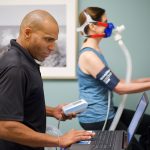The Purpose of Fitness Evaluations
When asking ‘which of the following is the main goal of fitness evaluations?’, it’s pivotal to understand their multifaceted aims. Primarily, fitness evaluations seek to establish a baseline of one’s physical capacities. This helps in identifying the strengths and limitations of an individual. With this knowledge, fitness professionals can craft personalized exercise regimens that cater to the unique needs of each person.

These evaluations are not just about measuring current fitness levels; they also set the stage for tracking progress over time. By having consistent standards and metrics to compare against, individuals and trainers can see the tangible results of their hard work. Furthermore, fitness evaluations play a critical part in ensuring the safety of an exercise program. They help in uncovering any potential health risks or physical constraints that should be considered during workout planning. In essence, the main goal is to provide a comprehensive understanding of one’s physical state, which serves as the cornerstone for any effective and safe fitness journey. When assessing fitness levels, it’s important to identify which of the following events is not typically included in fitness evaluations for accurate tracking and safety.
Key Components of a Fitness Assessment
When delving into the elements that make up a fitness evaluation, several key components stand out. Each element helps to paint a detailed picture of an individual’s fitness level. Here are the aspects commonly included in a comprehensive fitness assessment:
- Body Composition Analysis: This involves measuring body fat percentage, lean muscle mass, and overall body weight. It provides insight into the physical makeup of a person and sets a benchmark for health.
- Cardiovascular Endurance Tests: These tests gauge how well the heart and lungs work together to supply oxygen during sustained activity. Common tests include running or walking on a treadmill for a set time or distance.
- Muscular Strength and Endurance Assessments: Through exercises like push-ups or lifting weights, trainers can assess how strong muscles are and how long they can perform a task before fatigue sets in.
- Flexibility Measurements: Using tests such as the sit-and-reach, fitness professionals evaluate how flexible one is, which is crucial for overall mobility and injury prevention.
- Balance Testing: Balance is key for preventing falls and maintaining a healthy musculoskeletal system. Simple tests can reveal one’s balance and stability levels.
Addressing ‘which of the following is the main goal of fitness evaluations?’, each component targets a specific area of fitness. Together, they contribute to a full understanding of an individual’s health and physical abilities.
The Role of Fitness Evaluations in Personal Training
Personal trainers rely heavily on fitness evaluations to guide their work. The evaluations reveal key data about a client’s health and fitness. This data serves as the foundation for designing safe, effective workout plans. One key goal of these evaluations is to prevent injuries by identifying any risk factors.
Trainers use the assessments to set realistic and achievable goals for their clients. These goals may focus on weight loss, muscle gain, or improving endurance. Goal setting is central to keeping clients motivated and on track with their fitness journey. Moreover, the evaluations allow trainers to monitor progress and make necessary adjustments to the exercise regimen.
Overall, in personal training, determining ‘which of the following is the main goal of fitness evaluations?’ points to tailored program development. Fitness evaluations ensure that training is personalized, aligning with individual health profiles and fitness objectives. They make the trainer-client relationship more effective by providing a clear pathway to success. Incorporating a yoga ball office chair can enhance fitness evaluations by promoting core strength and posture, aligning with personalized training goals for a healthier workspace.
How Fitness Evaluations Measure Health and Fitness Levels

Fitness evaluations measure various aspects of health and fitness. They provide a clear picture of one’s physical status. Trainers and clients alike can use these measurements to tailor fitness plans. This ensures that goals set are reachable and suitable for the individual’s condition. The evaluations usually consist of several tests. Each test focuses on a different area of health and fitness.
Key tests include body composition, cardiovascular endurance, and muscular strength. Flexibility and balance are also essential metrics evaluated. Body composition tests calculate fat versus lean muscle in the body. Cardio tests determine heart and lung performance during activities. Muscular tests measure strength and how muscles endure over time. Flexibility tests check the range of motion in joints. Balance tests ascertain stability and coordination.
Together, these tests offer a comprehensive view of one’s fitness level. They help in pinpointing strengths and areas that need improvement. By doing so, they play a central role in shaping the path to better health and fitness. Fitness evaluations lay the foundation for personalized fitness programs. They guide trainers in developing workouts that align with clients’ health statuses.
In conclusion, fitness evaluations are essential in measuring health and fitness levels. They help in the main goal of creating tailored fitness plans. These evaluations provide data necessary for safe and effective training. Understanding one’s measurements can help in setting realistic fitness goals. This makes the use of fitness evaluations vital in personal training. They ensure that the exercise program created is the right fit for the client’s needs.
The Importance of Goal Setting in Fitness Evaluations
Goal setting is crucial in fitness evaluations. It anchors the client’s journey towards better health and fitness. Setting goals drives motivation and gives a clear direction for personal training plans. Without clear goals, fitness programs lack focus and can lead to suboptimal results.
Here is why goal setting is essential in the context of fitness evaluations:
- Provides Clear Targets: Goals establish what clients aim to achieve, be it weight loss, muscle gain, or improved endurance.
- Motivates Clients: Having specific goals fuels the dedication needed to adhere to exercise routines. It fosters a sense of accomplishment as milestones are reached.
- Guides Personalized Training: Fitness evaluations use goal setting to tailor workouts. This ensures exercises are aligned with individual capabilities and objectives.
- Enhances Progress Tracking: Set goals help in measuring progress. They make it easier to adjust training methods if results are not as expected.
- Injury Prevention: Goals based on evaluation results reduce the risk of overtraining. This helps in avoiding injuries by not pushing beyond safe limits.
Incorporating goal setting into fitness evaluations answer ‘which of the following is the main goal of fitness evaluations?’. It ensures that the fitness journey is structured around meaningful and attainable objectives. This increases the likelihood of adherence and success in any fitness program. Ultimately, the art of setting suitable goals is as important as the evaluation itself. A lack of clear goals is a common barrier to good fitness, highlighting the importance of incorporating goal setting into fitness evaluations.
Understanding the Different Types of Fitness Tests
To understand ‘which of the following is the main goal of fitness evaluations?’, it’s crucial to know the various fitness tests used during these assessments. Each test is designed to measure specific health and fitness components, offering valuable insights into an individual’s capabilities. Here, we’ll explore the different types of tests commonly incorporated into a fitness evaluation:
- Body Composition Tests: These analyze the percentage of fat, bone, water, and muscle in the body. Essential methods include skinfold measurements and bioelectrical impedance analysis.
- Cardiorespiratory Endurance Tests: Typically, these involve activities like treadmill running or bike riding that measure how well the heart and lungs work together under exertion.
- Muscular Strength Tests: Exercises such as bench presses or leg presses assess the maximum weight one can lift, indicating muscle strength.
- Muscular Endurance Tests: These determine how long muscles can sustain an activity. Common tests include timed sit-ups or push-ups.
- Flexibility Tests: Methods like the sit-and-reach test measure the range of motion, an indicator of flexibility in various joints.
- Agility Tests: These challenge an individual’s ability to change direction rapidly while maintaining speed, balance, and coordination.
- Balance Tests: From simple one-leg stands to complex equipment-based tests, balance tests assess stability and risk of falls.

Understanding the plethora of tests available is key in formulating a comprehensive fitness evaluation that aligns with the main goal – customizing an effective and safe fitness plan tailor-made for an individual’s needs.
Interpreting Fitness Evaluation Results
Interpreting the results of fitness evaluations is key to achieving personal health goals. Here’s how professionals read and use the data:
- Analyze Benchmarks: Experts compare results to norms or past data to spot progress or decline.
- Identify Strengths and Weaknesses: The data shows where one excels and where improvement is needed.
- Tailor Fitness Plans: Results guide trainers in fine-tuning workouts for better results.
- Set New Goals: Current fitness levels determine what goals are realistic and challenging.
- Monitor Health Risks: High body fat or poor balance can signal health dangers. Early detection is critical.
- Motivate Clients: Visible improvements in results can boost morale and dedication to exercise.
Clear interpretation of these results supports the main goal of fitness evaluations: to steer the journey toward peak fitness with precision and care.
The Impact of Fitness Evaluations on Exercise Programs
Fitness evaluations powerfully shape exercise programs. Let’s explore this impact in detail.
- Tailoring Exercise to Individual Needs: By assessing physical strengths and weaknesses, trainers create workouts best suited to each client.
- Enhancing Progress and Results: Regular evaluations adjust programs, keeping clients on track towards their goals.
- Injury Prevention Strategies: Knowing one’s limits through evaluations prevents exercises that could cause harm.
- Facilitating Clear Communication: Results provide a clear language for trainers and clients to discuss progress and hurdles.
- Boosting Confidence and Motivation: Seeing tangible progress from objective data can encourage continued effort.
In essence, answering ‘which of the following is the main goal of fitness evaluations?’ leads to improved and personalized exercise programs. This subsequently elevates the overall fitness experience, ensuring each individual’s path to health is as effective as possible.

